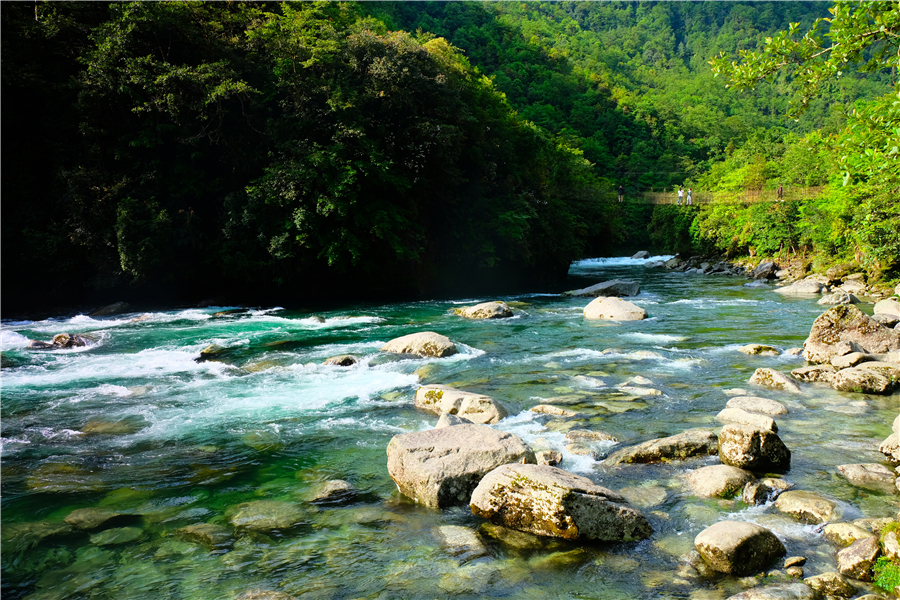Battle against pollution: The return of clear water
Water is essential to life on Earth, however, water pollution is one of the biggest ecological crises we are facing today on a global scale.
Water pollution control in China started as early as in 1980s, a time when construction was developing in a massive scale and speed, putting an heavy pressure on water bodies across the country.

Pukawang River in Nujiang Lisu Autonomous Prefecture of Yunnan Province
Exploring the right way
The first group of measures introduced in the ninth and tenth Five-Year Plans focused mainly on seven key basins (Yangtze River, Yellow River, Pearl River, Songhua River, Huaihe River, Haihe River, and Liaohe River basins).
Although the outcome saw some improvements in the ground water quality, the plans lacked thorough evaluation of the degrees of pollution in various water bodies while the targets were set too ahead.
The Environmental Quality Standards for Surface Water was introduced in 2002, in which China's surface water is classified into five grades from I to V, with Grade I defined as the best, while water at Grade V is for agriculture and general landscape usage, and water "inferior to Grade V" is called "unusable."
The ground water quality has seen some gradual improvement. However, in many water areas across the country, eutrophication (enrichment of a water body with minerals and nutrients leading to the excessive growth of algae) became a difficult problem to solve.
The 'strictest plan'
In 2014, an annual report released by the Ministry of Ecology and Environment (MEE) about the surface water quality in 2013 showed moderate pollution with several urban water bodies severely polluted. The percentage of water "inferior to Grade V" was still high at nine.
With growing concern as well as thorough study of the country's water pollution situation, in April 2015, the State Council released the Action Plan for Prevention and Control of Water Pollution, also known as the "ten-point plan."
The action plan proposed that by 2020, above 70 percent (75 percent by 2030) of the water areas of the seven key basins will have at least Grade Ⅲ water quality standard; over 93 percent (95 percent by 2030) of the drinking water sources in prefecture-level cities will reach at least Grade Ⅲ.

Panlong River in Kunming City, Yunnan Province
Bringing back clear water
Yunnan Dianchi Lake was one of the most polluted lakes in China. It has suffered from eutrophication since the early 2000s. However, Dianchi Lake was a major source of freshwater fish in Kunming City 30 years ago. As the city grew, industrial fertilizers and a continuous discharge of untreated sewage directly into the lake eventually turn it into a pile of dead green water enveloped in the stench of the algae.
As part of the 12th Five-Year Plan, Kunming City invested 42 billion yuan (5.8 billion U.S. dollars) in pollution control in the Lake. A series of river redirection into the lake also helped reducing the algae in Dianchi. Starting from 2016, the water quality has seen a significant improvement.
In 2018, the previous "inferior than Grade V" water quality reached VI and remained the same in 2019. Bird-lovers are seeing more and more migratory birds stopping over at Dianchi Lake every year.

Dianchi Lake in Kunming City
Looking forward
According to the latest report released by MEE in May this year, the surface water at and above Grade III in China has reached 74.9 percent, while the "inferior than Grade V" water has reduced to 3.4 percent, meeting the targets set in the "ten-point plan."
Going forward, eliminating "inferior than Grade V" water is still a long battle to fight. Restoring lake and river, implementing better sewage treatment systems, tackling urban and rural water disposal problems, as well as evaluating high-risk industries along water bodies are the four major tasks in the coming years.
Photo by Zhang Tong, Huang Jichun, Zhou Can, Gu Bin and Li Hengqiang; editor: John Li